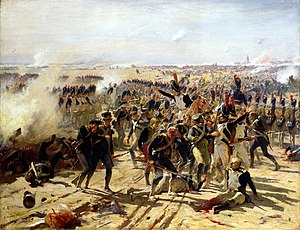Aspern-Essling
| Battle of Aspern-Essling | |||||||
|---|---|---|---|---|---|---|---|
| Part of War of the Fifth Coalition | |||||||
 The Battle of Aspern-Essling, May 1809 by Fernand Cormon |
|||||||
|
|||||||
| Belligerents | |||||||
|
|
|
||||||
| Commanders and leaders | |||||||
|
|
|
||||||
| Strength | |||||||
| 27,000 (First day) 66,000 (Second day) |
95,800 (First day) 90,800 (Second day) |
||||||
| Casualties and losses | |||||||
|
23,000 total: 16,000 wounded |
23,300 total: 16,300 wounded 800 captured |
||||||
23,000 total:
23,300 total:
In the Battle of Aspern-Essling (21–22 May 1809), Napoleon attempted a forced crossing of the Danube near Vienna, but the French and their allies were driven back by the Austrians under Archduke Charles. The battle was the first time Napoleon had been personally defeated in over a decade. However, Archduke Charles failed to secure a decisive victory as Napoleon was able to successfully withdraw most of his forces.
At the time of the battle Napoleon was in possession of Vienna, the bridges over the Danube had been broken, and the Archduke's army was near the Bisamberg, a hill near Korneuburg, on the left bank of the river. The French wanted to cross the Danube. A first crossing attempt on the Schwarze Lackenau on 13 May was repulsed with some 700 French losses.Lobau, one of the numerous islands that divided the river into minor channels, was selected as the next point of crossing. Careful preparations were made, and on the night of 19–20 May the French bridged all the channels on the right bank to Lobau and occupied the island. By the evening of the 20th many men had been collected there and the last arm of the Danube, between Lobau and the left bank, bridged. Masséna's corps at once crossed to the left bank and dislodged the Austrian outposts. Undeterred by the news of heavy attacks on his rear from Tyrol and from Bohemia, Napoleon ferried all available troops to the bridges, and by daybreak on the 21st, 40,000 men were collected on the Marchfeld, the broad plain of the left bank, which was also to be the scene of the Battle of Wagram.
The Archduke did not resist the passage. It was his intention, as soon as a large enough force had crossed, to attack it before the rest of the French army could come to its assistance. Napoleon had accepted the risk of such an attack, but he sought at the same time to minimize it by summoning every available battalion to the scene. His forces on the Marchfeld were drawn up in front of the bridges facing north, with their left in the village of Aspern (Gross-Aspern) and their right in Essling. Both places lay close to the Danube and could not therefore be turned; Aspern, indeed, is actually on the bank of one of the river channels. The French had to fill the gap between the villages, and also move forward to give room for the supporting units to form up.
...
Wikipedia
